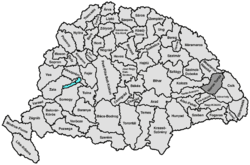Maros-Torda County
| Maros-Torda County Maros-Torda vármegye Comitatul Mureş-Turda Komitat Maros-Torda | |||||
| County of the Kingdom of Hungary | |||||
| |||||
|
Coat of arms | |||||
 | |||||
| Capital | Marosvásárhely 46°33′N 24°34′E / 46.550°N 24.567°ECoordinates: 46°33′N 24°34′E / 46.550°N 24.567°E | ||||
| History | |||||
| - | Established | 1876 | |||
| - | Treaty of Trianon | 4 June 1920 | |||
| Area | |||||
| - | 1910 | 4,203 km2 (1,623 sq mi) | |||
| Population | |||||
| - | 1910 | 219,589 | |||
| Density | 52.2 /km2 (135.3 /sq mi) | ||||
| Today part of | Romania | ||||
| Târgu Mureș is the current name of the capital. | |||||

Maros-Torda was an administrative county (comitatus) of the Kingdom of Hungary. Its territory is now in central Romania (eastern Transylvania). Its county seat was Marosvásárhely (Romanian: Târgu Mureș).
Geography
Maros-Torda county shared borders with the Hungarian counties Kolozs, Beszterce-Naszód, Csík, Udvarhely, Kis-Küküllő and Torda-Aranyos. The river Mureș/Maros flows through the county. Its area was 4188 km² around 1910.
History
Maros-Torda county was formed in 1876 on the territory of the Székely settlement Marosszék and part of Torda region. In 1920 after the Treaty of Trianon, the county became part of Romania except after the Second Vienna Award, between 1940–1944 during World War II. Its territory lies in the present (larger) Romanian county Mureș.
Demographics
In 1900, the county had a population of 197,618 people and was composed of the following linguistic communities:[1]
Total:
- Hungarian: 119,810 (60.6%)
- Romanian: 67,402 (34.1%)
- German: 7,446 (3.8%)
- Croatian: 107 (0.0%)
- Slovak: 85 (0.0%)
- Ruthenian: 9 (0.0%)
- Serbian: 4 (0.0%)
- Other or unknown: 2,755 (1.4%)
According to the census of 1900, the county was composed of the following religious communities:[2]
Total:
- Calvinist: 78,907 (39.9%)
- Greek Catholic: 44,507 (22.5%)
- Greek Orthodox: 28,989 (14.7%)
- Roman Catholic: 26,046 (13.2%)
- Unitarian: 7,917 (4.0%)
- Lutheran: 6,205 (3.1%)
- Jewish: 5,000 (2.5%)
- Other or unknown: 47 (0.0%)
In 1910, county had a population of 219,589 people and was composed of the following linguistic communities:[3]
Total:
- Hungarian: 134,166 (61.1%)
- Romanian: 71,909 (32.8%)
- German: 8,312 (3.8%)
- Ruthenian: 174 (0.0%)
- Slovak: 79 (0.0%)
- Croatian: 33 (0.0%)
- Serbian: 25 (0.0%)
- Other or unknown: 4,891 (2.2%)
According to the census of 1910, the county was composed of the following religious communities:[4]
Total:
- Calvinist: 85,692 (39.0%)
- Greek Catholic: 49,911 (22.7%)
- Greek Orthodox: 31,266 (14.2%)
- Roman Catholic: 30,828 (14.0%)
- Unitarianist: 7,894 (3.6%)
- Jewish: 7,550 (3.4%)
- Lutheran: 6,442 (2.9%)
- Other or unknown: 6 (0.0%)
Subdivisions
Around 1910, the subdivisions of Maros-Torda county were:
| Districts (járás) | |
|---|---|
| District | Seat |
| Maros alsó | Marosvásárhely, RO Târgu Mureş |
| Maros felső | Marosvásárhely, RO Târgu Mureş |
| Nyáradszereda | Nyáradszereda, RO Miercurea Nirajului |
| Régen alsó | Szászrégen, RO Reghin |
| Régen felső | Magyarrégen, RO Reghin-Sat |
| Urban counties (törvényhatósági jogú város) | |
| Marosvásárhely, RO Târgu Mureş | |
| Urban districts (rendezett tanácsú város) | |
| Szászrégen, RO Reghin | |
See also
References
- ↑ "KlimoTheca :: Könyvtár". Kt.lib.pte.hu. Retrieved 2012-12-06.
- ↑ "KlimoTheca :: Könyvtár". Kt.lib.pte.hu. Retrieved 2012-12-07.
- ↑ "KlimoTheca :: Könyvtár". Kt.lib.pte.hu. Retrieved 2012-06-20.
- ↑ "KlimoTheca :: Könyvtár". Kt.lib.pte.hu. Retrieved 2012-06-20.

